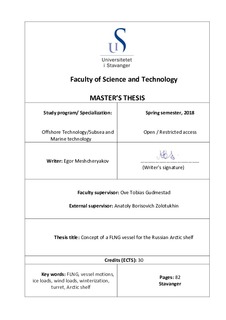| dc.description.abstract | The implementation of FLNG will introduce flexibility and mobility in the gas market. When we use pipeline transportation, the producer and the buyer are connected for decades by the created infrastructure, while in using the technology of LNG there is no such interdependence. There are also no dependences on transit countries.
Every day offshore production progresses into the deeper waters. Platforms, working in hundreds of kilometers from the coast, are created. To transport the extracted natural gas to a plant, which will turn it into LNG, it is necessary to build a corresponding length sea gas pipeline, that is a very expensive procedure. Moreover, transportation demands considerable energy too, so it also creates additional expenses. For this reason the idea to create the FLNG plants was proposed.
The main advantage of FLNG is mobility. After the depletion of deposits it is possible "to move" it to the new production site and continue to work. It significantly expands opportunities on payback of the project and will increase the profit: its price can be divided between several fields. Furthermore, application of FLNG plants will be important in minimizing the environmental impact of the coastal area.
There are several challenges on the way of realization of this idea in the Arctic. First, existing FNLG projects were created for working in the conditions of the warm seas. In the Arctic there are severe conditions. It is not only just cold there, but most of the territory is covered with ice. It provides essential technological complications. Secondly, in Russia there are no opportunities to build such technologically advanced vessels, because we don’t have enough experience, so we will have to collaborate with foreign partners. However, all these difficulties can be overcome. The main thing is that the necessary resource base is available here. It is enough to mention the huge Shtokman field, located 600 kilometers from the coast. In this work, I will emphasis on the design conditions for possible FLNG vessel on the Arctic shelf, winterization of the FLNG vessel and positioning of the vessel against drifting ice. | nb_NO |
